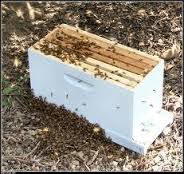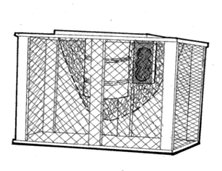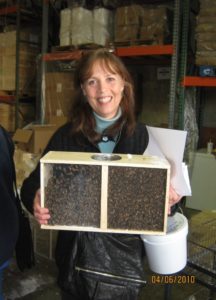There was an informative webinar mid-January from Bee Culture Magazine [“The Kim and Jim Show”] that was all about packages. You can still view the one-hour broadcast at Bee Culture webpage www.beeculture.org Look for it filed under events.
Kim and Jim discussed only packages but their comments would generally apply to nucs, although with a nuc you do not need be concerned about queen release and of course nuc installation is not nearly as complicated. Of particular interest you might listen to Jim’s initial discussion, with bulleted points “before you leave home”, “the annual experience” and the “trip home.” I summarize his points here and have added information on nucs as appropriate.
His talking points on trip to pick up packages (or if you are picking up a nuc) included: have good idea of how to install, take GPS (so you don’t get lost), take tie-down material and hose to water the bees (dependent upon how many packages/nucs you are getting, distance back home and type of vehicle you are using), have a way to avoid direct wind or sunlight onto the packages/nucs, and, most important of all, be sure individuals are not allergic to bee stings, or bee smell if packages/nucs are to be transported within a vehicle itself.
At the pickup site, Jim pointed out that it is likely to be a chaotic, energized, festive atmosphere, with bees everywhere (disoriented bees crawling and flying, with hobo bees sometimes plentiful on outside of packages (likely on outside of nucs depending upon when entrance were closed) that are difficult to remove). Jim’s advice – enjoy the atmosphere. One additional point he made was you, like everyone else, will likely have questions but the individual(s) dispensing the packages/nucs will not have time for detailed answers. [If getting packages, both Glory Bee and Ruhl have a handout you can read.] He recommended you ask questions of other beekeepers while (patiently) waiting to pick up your order. They may or may not have an answer. Keeping with the Plan Ahead advice, he suggested you seek to resolve your questions before you go to the distribution site. Mentors also should be able to answer your questions.
For the trip home, Jim recommended you not tarry [drive-thru coffee but not an hour-long breakfast/lunch in your favorite restaurant], expect to have at least one bee escape from inside the vehicle interior, keep the package(s)/nuc(s) well ventilated and shaded. Do NOT confine them to a closed box, use screening to close nuc entrances and don’t worry and especially DON’T PANIC, (they are ONLY BEES). Expect them to generate lots of heat plus expect them to be noisy.
When you arrive to your apiary site, the key is to BE READY. Be prepared to install (no time to start assembling your equipment), even though it is likely to be cold, windy, & rainy. You can hold package(s) in cool dry place, spraying sugar water on their cage generously for a day, 2-3 at most, waiting for better weather but plan to do it RIGHT AWAY. With nucs, you can delay one-two weeks before you transfer frames and bees to a larger brood box so wait for a decent weather day.
The key to starting a package of bees or with a nuc is to HAVE EVERYTHING READY, tools, hive stand, feeder, boxes, tops, lids, etc. Install packages and place your new nuc in the apiary site, do NOT install at a convenient site, like your porch or driveway, with plans to move them later to their final apiary site. Have assembled hive box, sitting on its bottom board on the hive stand if starting a package. Install quickly without rushing. After a big sigh of relief, and admiring your accomplishment, feed packages and nucs and continue doing so for at least 3 weeks or until they stop taking your proffered sugar water.
The video goes on to discuss two methods of package installation. Jim recommended an indirect (in-box) release of the packaged bees (bees are not shaken from their shipping cage, only the queen (still in her cage) is removed and placed on top of or between frames) while Kim recommends shaking bees from the package. Either work. My book HONEY BEE BIOLOGY AND BEEKEEPING AND THE BEEKEEPERS HANDBOOK illustrate both (and additional) methods. With packages, direct release of a queen risks queen failure, so leave her within her cage at package installation. Nucs do not need queen caging but on first nice day you might reconfirm queen presence by looking for eggs, if you can do so.
February/March is good time to check on bees. You can emergency feed if light on stores (heft hive form back or do a quick examination of colony top) but use a dry sugar source as the extra moisture from syrup feeders only adds additional moisture stress. Please make notes of losses – I will be back to OR by March meeting and will be asking you to participate in the PNW bee loss/management survey.



